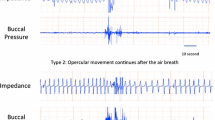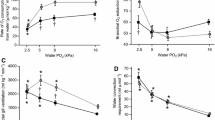Summary
-
1.
When exposed to progressive hypoxia in shallow seawater,Carcinus maenas partially emerged into air and aerated its branchial chambers by reversing the direction of their irrigation. Emersion took place at a meanP I, O2 of 18 mm Hg at 6 °C, 21 mm Hg at 12 °C and 59 mm Hg at 17 °C.
-
2.
At low oxygen tensions submerged crabs underwent a progressive bradycardia. Heart rate first became significantly lower than the rate in normoxia below aP I O2 of 30 mm Hg at 6 °C, 40 mm Hg at 12 °C and below 60 mm Hg at 17 °C. The proportion of total time spent irrigating the gills in a reversed direction increased in hypoxic seawater (P I, O2< 50 mm Hg), but respiratory rate was unchanged.
-
3.
Emersion into air always occurred during a reversal of irrigation and was accompanied by prolonged reversals, with consequent aeration of the branchial chambers, and by an immediate and maintained tachycardia back towards the rate in normoxic seawater. Crabs emerging into a hypoxic atmosphere (\(P_{O_2 } \) < 10mm Hg) showed neither a maintained reversal of irrigation nor a maintained tachycardia.
-
4.
The oxygen tension of the postbranchial blood (P a,O2) was 94 mm Hg in crabs submerged in normoxic seawater (P I,O2 146 mm Hg) at 12 ° C. During progressive hypoxiaP a, O2 fell in direct proportion to the drop inP I,O2. Emersion caused no significant increase inP a, O2.
-
5.
The mean oxygen content of postbranchial blood (C a, O2) was 0.96 vol. % at aP I,O2 of 145 mm Hg.C a, O2 fell to 0.19 vol.-% in submerged crabs at a meanP I,O2 of 25 mm Hg but rose to 0.45 vol.-% following 10 min emersion into air at a meanP I, O2 of 22 mm Hg.
-
6.
The results provide evidence of a respiratory role for the emersion response and also of an adaptive role for the high affinity of the blood pigment inCarcinus.
Similar content being viewed by others
References
Ahsanullah, M., Newell, R. C.: Factors affecting the heart rate of the shore crabCarcinus maenas (L.). Comp. Biochem. Physiol.39A, 277–287 (1971)
Arudpragasam, K. D., Naylor, E.: Gill ventilation and the role or reversed respiratory currents inCarcinus maenas (L.). J. exp. Biol.41, 299–308 (1964a)
Arudpragasam, K. D., Naylor, E.: Gill ventilation volumes, oxygen consumption and respiratory rhythms inCarcinus maenas (L.). J. exp. Biol.41, 309–322 (1964b)
Bohn, G.: Sur le renversement du courant respiratoire chez les Decapodes. C. R. Acad. Sci. (Paris)125, 539–542 (1897)
Borradaile, L. A.: On the mouthparts of the shore crab. J. Linn. Soc. (Zool.)35, 115–143 (1922).
Butler, P. J., Taylor, E. W.: Responses of the dogfishScyliorhinus canicula L. to slowly induced and rapidly induced hypoxia. Comp. Biochem. Physiol.39A, 307–323 (1971)
Cameron, J. N., Randall, D. J., Davis, J. C.: Regulation of the ventilation-perfusion ratio in the gills ofDasyatis sabina andSqualus suckleyi. Comp. Biochem. Physiol.39A, 505–519 (1971)
Henze, M.: Über den Einfluß des Sauerstoffdruoks auf den Gaswechsel einiger Meerestiere. Biochem. Z.26, 255–278 (1910)
Holeton, G. F., Randall, D. J.: The effect of hypoxia upon the partial pressure of gases in the blood and water afferent and efferent to the gills of the rainbow trout. J. exp. Biol.46, 317–327 (1967)
Hughes, G. M., Knights, B., Scammell, C. A.: The distribution ofp o 2 and hydrostatic pressure changes within the branchial chambers in relation to gill ventilation of the shore crabCarcinus maenas L. J. exp. Biol.51, 203–220 (1969)
Johansen, K., Lenfant, C., Mecklenberg, T. A.: Respiration in the crabCancer magister. Z. vergl. Physiol.70, 1–19 (1970)
Johnson, M. L.: The control of respiratory movements in Crustacea by oxygen and carbon dioxide II. J. exp. Biol.13, 467–475 (1936)
Jones, J. D.: Comparative physiology of respiration. London: Edward Arnold 1972
McMahon, B. R., Wilkens, J. L.: Simultaneous apnoea and bradycardia in the lobsterHomarus americanus. Canad. J. Zool.50, 165–170 (1972)
Prosser, C. L., Brown, F. A.: Comparative animal physiology, 2nd ed. Philadelphia: W. B. Saunders 1961
Randall, D. J., Smith, J. C.: The regulation of cardiac activity in fish in a hypoxic environment. Physiol. Zool.40, 104–113 (1967).
Redmond, J. R.: The respiratory function of haemocyanin in Crustacea. J. cell. comp. Physiol.46, 209–247 (1955)
Redmond, J. R.: The respiratory function of haemocyanin. In: Biochemistry and physiology of haemocyanins, ed. F. Ghiretti. New York: Academic Press 1968
Satchell, G. H.: Circulation in fishes. Cambridge: University Press 1971
Slyke, D. D. van, Neill, J. M.: The determination of gases in blood and other solutions by vacuum extraction and manometric measurement. J. biol. Chem.61, 523–573 (1924)
Taylor, E. W., Butler, P. J.: The behaviour and physiological responses of the shore crabCarcinus maenas during changes in environmental oxygen tension. Neth. J. Sea Res. (in print) (1973)
Truchot, J.-P.: Fixation de l'oxygène par le sérum deCarcinus maenas (L.) (Crustacé Décapode Brachyoure). C.R. Acad. Sci. (Paris)272, Sér. D, 984–987 (1971)
Truchot, J.-P.: Fixation et transport de l'oxygène par le sang deCarcinus maenas L. (Crustacé Décapode, Brachyoure): variations en fonction de la temperature et de la salinité. Neth. J. Sea Res. (in print) (1973)
Wallace, J. C.: Activity and metabolic rate in the shore crab,Carcinus maenas (L.). Comp. Biochem. Physiol.41A, 523–533 (1972)
Young, R. E.: The physiological ecology of haemocyanin in some selected crabs. II. The characteristics of haemocyanin in relation to terrestrialness. J. exp. mar. Biol. Ecol.10, 193–206 (1972).
Author information
Authors and Affiliations
Additional information
This work was supported by Science Research Council Equipment Grants to E.W.T. & P.J.B.
P.J.S. held a Research Studentship from the S.R.C.
Rights and permissions
About this article
Cite this article
Taylor, E.W., Butler, P.J. & Sherlock, P.J. The respiratory and cardiovascular changes associated with the emersion response ofCarcinus maenas (L.) during environmental hypoxia, at three different temperatures. J. Comp. Physiol. 86, 95–115 (1973). https://doi.org/10.1007/BF00702531
Received:
Issue Date:
DOI: https://doi.org/10.1007/BF00702531




